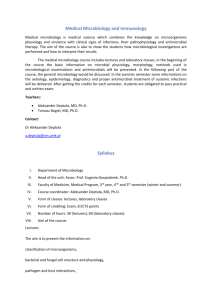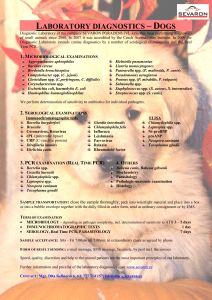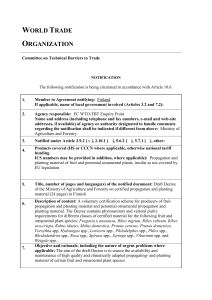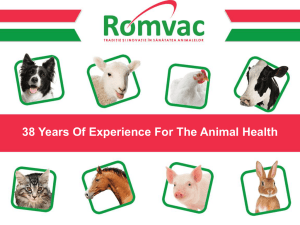1. The organization of classes. Microbiological laboratory safety
advertisement
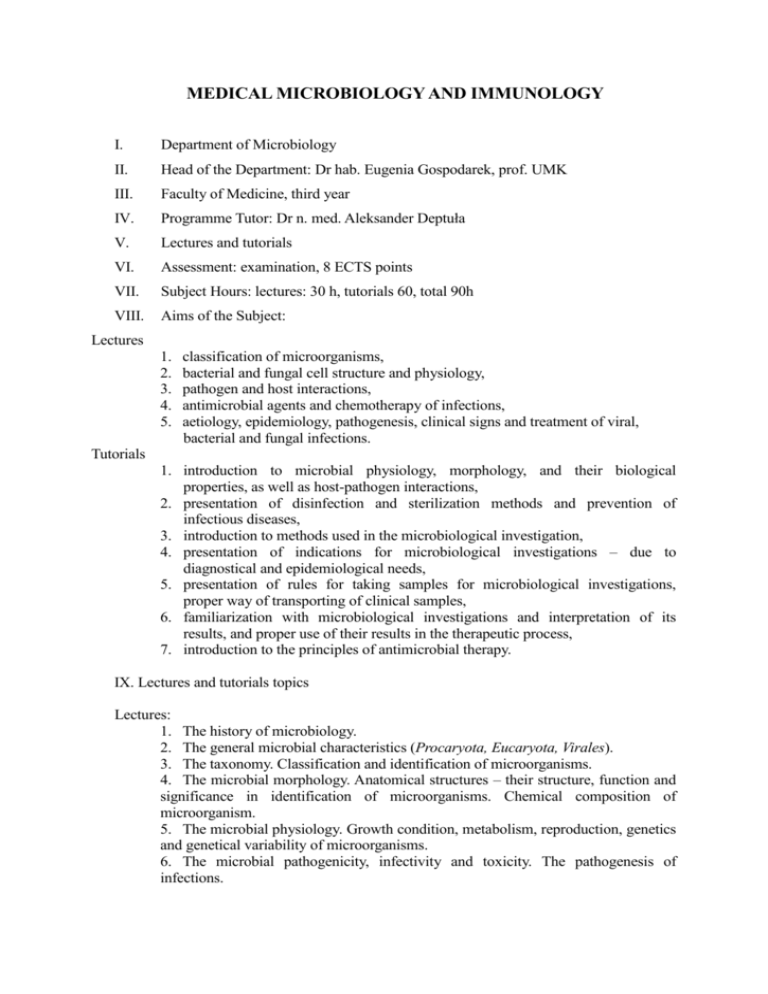
MEDICAL MICROBIOLOGY AND IMMUNOLOGY I. Department of Microbiology II. Head of the Department: Dr hab. Eugenia Gospodarek, prof. UMK III. Faculty of Medicine, third year IV. Programme Tutor: Dr n. med. Aleksander Deptuła V. Lectures and tutorials VI. Assessment: examination, 8 ECTS points VII. Subject Hours: lectures: 30 h, tutorials 60, total 90h VIII. Aims of the Subject: Lectures 1. 2. 3. 4. 5. classification of microorganisms, bacterial and fungal cell structure and physiology, pathogen and host interactions, antimicrobial agents and chemotherapy of infections, aetiology, epidemiology, pathogenesis, clinical signs and treatment of viral, bacterial and fungal infections. Tutorials 1. introduction to microbial physiology, morphology, and their biological properties, as well as host-pathogen interactions, 2. presentation of disinfection and sterilization methods and prevention of infectious diseases, 3. introduction to methods used in the microbiological investigation, 4. presentation of indications for microbiological investigations – due to diagnostical and epidemiological needs, 5. presentation of rules for taking samples for microbiological investigations, proper way of transporting of clinical samples, 6. familiarization with microbiological investigations and interpretation of its results, and proper use of their results in the therapeutic process, 7. introduction to the principles of antimicrobial therapy. IX. Lectures and tutorials topics Lectures: 1. The history of microbiology. 2. The general microbial characteristics (Procaryota, Eucaryota, Virales). 3. The taxonomy. Classification and identification of microorganisms. 4. The microbial morphology. Anatomical structures – their structure, function and significance in identification of microorganisms. Chemical composition of microorganism. 5. The microbial physiology. Growth condition, metabolism, reproduction, genetics and genetical variability of microorganisms. 6. The microbial pathogenicity, infectivity and toxicity. The pathogenesis of infections. 7. The influence of physical factors and chemical substancies on microbial biological properties. Disinfection and sterilization. The overview of disinfectants and antiseptics and their mechanisms of action. The resistance of microorganisms to disinfectants. 8. The antimicrobials – classification, groups overwiev, mechanisms of action. Antimicrobial resistance mechanisms. Methods of antimicrobial resistance testing. The general rules of antimicrobial treatment. 9. The basis of infective immunology. Immunological methods used in microbiological investigations. Immunoprophylaxis and immunotreatment. Vaccines. Immunity sera and immunoglobulines. 10. The bacteriology. Overwiev of bacteria pathogenic for human. 11. The virology. 12. The mycology. 13. Respiratory tract infections. 14. Urinary tract infections. 15. Gastrointestinal tract infections and foodborne diseases. 16. Sexually transmitted diseases. Intra-uterine and neonatal infections. 17. Skin, mucosal and eye infections. 18. Surgical infections. 19. Infections caused by anaerobic bacteria. 20. Central nervous system infections. 21. Bloodstream infections. 22. The microbiological investigation of autopsical samples. 23. The diagnostics of infections. Sampling, storage conditions and transporting of clinical specimens for microbiological investigations. 24. Hospital acquired infections. Infection prevention and control, epidemiological investigation, microorganisms typing methods – the role of microbiologist. Tutorials: 1. The organization of classes. Microbiological laboratory safety rules. The Procaryota cell structure. Microscopy techniques. 2. Staining methods and microbial morphology. 3. Methods used for microbiological investigations (part I). 4. Methods used for microbiological investigations (part II). 5. Methods for antimicrobial sensitivity testing. 6. Methods for detection of antimicrobial resistance and interpreting of antimicrobial sensitivity testing results. 7. Test. 8. The characteristic of the Micrococcaceae family. 9. The characteristic of the Streptococcaceae family. 10. Disinfenction and sterilization methods. Visiting the Central Sterilization and DDD department of Dr A. Jurasz University Hospital in Bydgoszcz. 11. The characteristics of: Corynebacterium spp., Listeria spp., Haemophilus spp. 12. The characteristic of sporing bacilli: Bacillus spp. i Clostridium spp. 13. The anaerobes culture methods. Charactersitics of non-sporing anaerobes: Bacteroides spp., Porphyromonas spp.., Prevotella spp., Fusobacterium spp., Peptostreptococcus spp., Peptococcus spp. 14. Test. 15. The microbiological diagnostics of selected spiral bacteria: Helicobacter spp., Campylobacter spp. 16. The characteristics of the Enterobacteriaceae family (part I: Eschrichia spp., Proteus spp., Klebsiella spp., Citrobacter spp., Serratia spp., Enterobacter spp.) 17. The characteristics of the Enterobacteriaceae family (part II: Salmonella spp., Shigella spp., Yersinia spp.) 18. The characteristics of:: Acinetobacter spp., Stenotrophomonas spp., Burkholderia spp., Pseudomonas spp., Neisseria spp., Moraxella spp. 19. Sexually transmitted microorganisms. 20. The characteristcs of acid-fast microorganisms (Mycobacterium spp.). 21. The yeasts – methods for detection and identification. 22. The characteristics of dermatophytes and moulds. 23. Staff and hospital environment microbiological investigation. Disinfectants efficacy testing. 24. Tests. 25. Methods for sampling and transporting clinical samples for microbiological investigation. The human normal flora. 26. The diagnostics of respiratory tract infections. 27. The diagnostics of urinary and gastrointestinal tract infections. 28. The diagnostics of central nervous system infections. The eye infections. 29. The skin infections. The diagnostics of bloodstream infections. 30. The interpretation of microbiological investigation results. X. Self-study topics: ----------XI. Booklist: 1) Murray PR, Rosenthal KS, Pfaller MA: Medical microbiology. MOSBY Elsevier, 2009 XII. Detailed list of required practical skills and confirmation of completing: Name: Year of study: Group: Academic year: Date Recognizing of normal human organs on slides stained with different histological techniques. Confirmation of completing Notes


